That 30KW Uninterruptible Power Supply I recently scored for one dollar, still contained six out of the original complement of 48 batteries. They are 12V 40AH lead acid batteries.
 Unfortunately, this UPS had sat unpowered for nearly 4 years after the factory ceased operations. Of the six batteries, when I first measured their voltages they were: 12.85, 12.10, 11.98, 11.94, 4.47, 0.63V.
Unfortunately, this UPS had sat unpowered for nearly 4 years after the factory ceased operations. Of the six batteries, when I first measured their voltages they were: 12.85, 12.10, 11.98, 11.94, 4.47, 0.63V.
 That was a bit surprising, that 4 out of 6 would still seem to be somewhat functional after sitting idle for so long. Lead acid batteries tend to self-discharge, and suffer irreversible damage once they drop below operating voltage range.
That was a bit surprising, that 4 out of 6 would still seem to be somewhat functional after sitting idle for so long. Lead acid batteries tend to self-discharge, and suffer irreversible damage once they drop below operating voltage range.
I tried running a charge cycle on each of them, with a charger that includes a desulfation stage. The two really dead ones did not recover at all, even with multiple cycles. Disappointingly, during this process the 'best' one (12.85V) also died, dropping to near zero output voltage. Obviously it had gone open circuit internally. I haven't done load cycle testing of the 'maybe useable' 3 yet, and have low expectations of the results.
Anyway I have at least three 'hopeless case' lead acid batteries. (Actually, probably all six of them.) They'll go to the recycler, for a few dollars. But first, something I never got around to doing before. I'll dissect one of the dead ones, mostly just for curiosity.
There's another motivation as well. There's a lot of enthusiasm from some for 'restoring' old lead acid batteries by various means. Desulphation zappers being one of the claimed miracle cures. So, I want some pictures of just how bad the entropic chaos can get inside an old or mistreated lead-acid battery. To get an idea of whether a really dead battery could ever be 'restored.' Also a friend has mentioned to me the idea of home recycling of old batteries, and re-manufacturing the materials into new lead acid batteries (of some form.) How feasible might this be?
I won't talk about the chemistry of lead-acid batteries here. Easy to google it yourself. Or Wiki.
How do you take apart a sealed lead acid battery? They are designed to not be dismantled.
A: With some violence. Hammer, sharp wood chisel, and various other tools that don't take 'no' for an answer.
Bear in mind, this is a exploratory exercise. It's not meant to result in anything other than photos. Mr Finesse is not home today. Don your safety goggles, and enjoy.
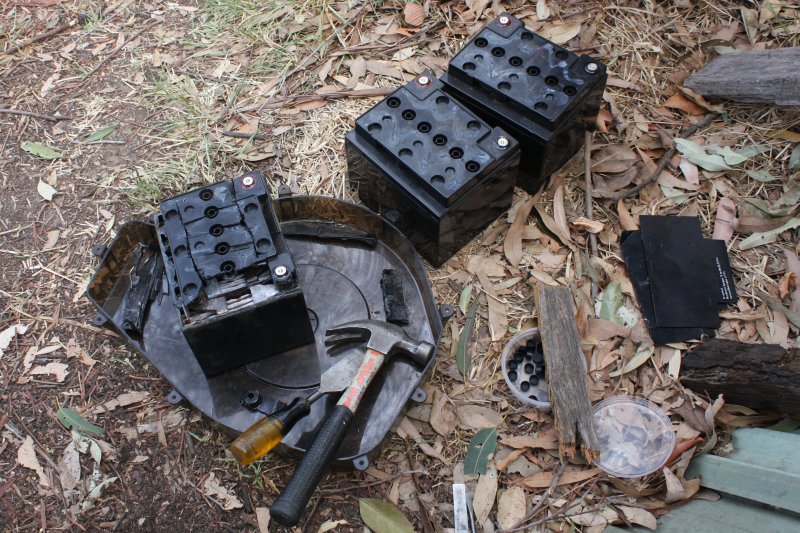 The 'workbench.'
The 'workbench.'
Outside on the ground. Of course.
First steps:
- Remove the nice M6 stainless steel terminal bolts. Keeping them.
- Chisel off the covers over the cell vent caps.
- Remove the vent caps. This was interesting — every single cell was well below atmospheric pressure, by about the same amount. Each one made a strong 'suck' sound as the cap came off and air rushed in. So I know that none of the cells were open to air due to faulty glue seals or whatever.
The caps are nice, neoprene rubber. Might be useful as connector covers or plugs. Keeping them.
Now I could determine if these are wet cells, or the kind that contains gell or fiber spacers that are merely damp with acid. I upturned a battery (over the tray.) Nothing runs out. OK, good, I don't have to guard against acid spashes.
Next, some preliminary chiselling to get an idea of the general internal layout of the top structures. Simple enough. The only awkward bits are the inter-cell connections, that are cast in epoxy inside plastic cylinders integral with the top plate. Those had to be individually dealt with. (Boltcutters)
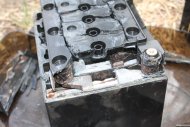 |
 |
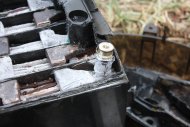 |
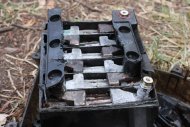 |
 |
1. Close up. The front battery terminal is the Negative. In each cell the silvery-lead top bar is the negative; the brownish top bar is the positive.
2. Most of the top removed. The alternating top electrodes are visible.
3, 4. The nice clean plated-brass terminal with M6 thread, is soldered into the end negative lead bar. The seal was an O-ring and poured epoxy.
5. All the silvery lead structures are still maleable, while the brown positive ones are extremeley brittle. Most of them broke off from the plates, with barely any force needed. The brittleness of the positive structures in each cell is clearly a predominant failure mode.
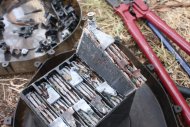 |
 |
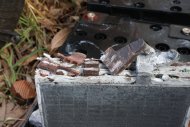 |
 |
 |
1. Pulling one of the cells out of its slot in the case. More breakages of the brownish structures.
2. All the cells out. The brown plates just keep falling apart.
A thought that occurs to me — since there's nothing but plastic and lead in the plane along the top of the battery bottom casing, it would be possible to power-saw through there neatly. Resulting in a useful casing for constructing a new battery.
3. More of the brown material fracturing with ease. It has virtually no strength at all. I now think that 'best' cell that suddenly went open circuit, was probably due to me lifting it and putting it back down on the concrete floor. The slight jar probably fractured one (some?) of the top plate connections.
4. A collection of bits that just fell off.
5. By the time I put the cells back in the case (for convenience) all of the cell Positive terminals had fallen off.
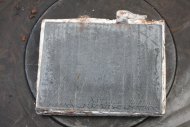 |
 |
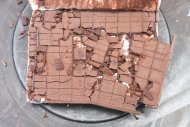 |
 |
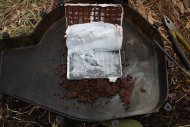 |
1. View of a cell outer Negative plate. All of them had that fracturing effect in the lower area. Some more than this.
2, 3. Peeling back the outer Negative plate, to see the next Positive plate. Wow, it's just completely junk. Lightly touching it, it disintegrates. I think there are many physical breaks already in the matrix of supposedly solid conductors.
4. The separator sheet is quite firmly adhered to the Negative plates. If one was hoping to remove it entirely for some kind of recycling of the plates, it would be difficult.
5. A whole Positive plate brushed out to the tray. Dim photo; about as dim as the chances of 'restoring' any battery as decayed as this one.
I expect all six of these batteries from the UPS will be in similar condition to this. So load testing the 'good' ones should be interesting. But not rewarding.
These batteries don't need 'desulphation zapping.' They need a miraculous laying on of healing hands, able to cure massive structural failure. Which is not going to happen.